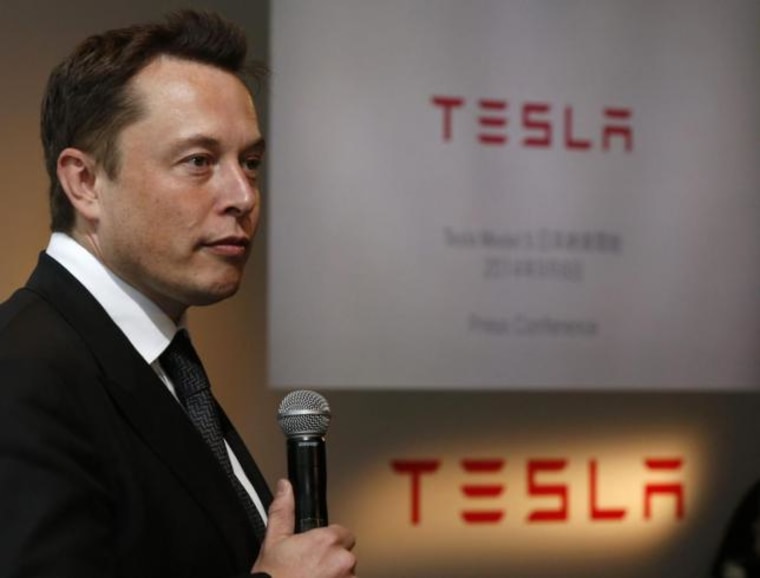By 2017, Tesla cars could be driving all the way across the country without any hands on the wheel, according to CEO Elon Musk and his vision for driverless technology. The enigmatic entrepreneur also had a few choice words for the media during the surprise announcement Wednesday, accusing journalists of "killing people" by over-reporting Tesla Autopilot crashes, which he described as "basically almost none."
Having teased a big announcement via Twitter for the past week, what Musk finally revealed late Wednesday was an enhanced version of the electric vehicle's autopilot software. By the end of next year, said Musk, Tesla would demonstrate a fully autonomous drive from, say, "a home in L.A., to Times Square ... without the need for a single touch, including the charging.”
Effective immediately, Tesla will equip all models with a network of cameras and other sensors capable of watching everything happening around the vehicle and making instant decisions on how to respond to potential problems. The new technology is a significant step up from the semi-autonomous Autopilot system now used on Tesla’s Model S sedan and Model X battery-SUV.
But Tesla cautioned that not all the new features will be activated immediately upon the launch of the Model 3, which is expected to occur sometime in late 2017. It first needs to clock “millions of miles of real-world driving” to ensure everything works properly. The maker is clearly hoping to avoid a repeat of the problems of the Autopilot system that has blamed for at least one fatal crash.
Related: U.S. Opens Investigation Into Tesla After Fatal Crash on 'Autopilot'
Getting vehicles to drive on their own has proven frustratingly difficult — Google, long seen as one of the leaders in the development of the technology, has acknowledged having more than a dozen mostly minor collisions with its prototypes. And Tesla’s semi-autonomous Autopilot has received much of the blame for a May 9 crash in Florida that killed a former Navy SEAL. Several other crashes, including a fatal one in China, are also under investigation, though not clearly linked to the technology.
The Feds approve
But that hasn’t dimmed the broad support for autonomous driving — and even more advanced driverless vehicles — shared by automakers and automotive regulators alike. Just one month ago, the U.S. Department of Transportation issued the first federal guidelines covering self-driving vehicles.
“This is a change of culture for us,” said Transportation Secretary Anthony Foxx, who has become a vocal proponent of the technology, arguing that it will eventually result in a sharp decline in highway crashes, injuries and deaths.
But journalists could be the ones holding back progress, suggested Musk, saying, "If, in writing some article that’s negative, you effectively dissuade people from using an autonomous vehicle, you’re killing people."
Musk and Tesla have also come under fire for what skeptics say was an over-ambitious roll-out of the preliminary Autopilot system. California-based Consumer Watchdog has noted that Tesla itself called the system a “beta,” and argued that the carmaker was using its owners to improve the system. That might be acceptable with smartphone software, but not with a motor vehicle, the non-profit organization has declared.
Taking it to the next level
Tesla also plans to have future buyers help it develop the new fully-autonomous system — something known in the automotive and tech communities as Level 5 autonomy. But the Silicon Valley company is taking a more cautious approach this time.
Each new vehicle will be equipped with eight separate cameras, according to Tesla, as well as radar and a dozen ultrasonic sensors that can gather a 360-degree view of the world at distances up to 820 feet. In turn, that data will be processed by what Tesla is calling a “neural net.”
Unlike a human driver, those cameras and other sensors won’t blink, get distracted by text messages or crying children in the back seat. But Tesla will need to make sure they also won’t make mistakes like those that contributed to the May 9th fatal crash. It appears the Model S camera confused a white truck trailer for the bright Florida sky, while the car’s radar thought the truck was an overhead highway sign.
Initially, new Tesla vehicles will have some of their potential functions disabled – including the forward collision warning with emergency auto-braking feature. The goal will be to “further calibrate” the new system and, when Tesla is confident it will work, turn them back on, one at a time, using the maker’s over-the-air update technology.
What could be more relaxing?
Only eventually will the vehicles get full Level 5 capability. But once that happens — and depending upon what state and local laws permit — a motorist would be able to take hands off the wheel, lay back and relax, possibly watch a movie, text or even catch a little extra sleep on the morning commute.
Tesla is by no means the only automaker sharing this vision. Start-ups like LeEco and Faraday Future, as well as more familiar names like General Motors, Toyota, Ford, and Mercedes-Benz have similar goals.
The race to automate driving has clearly shifted into high gear.
